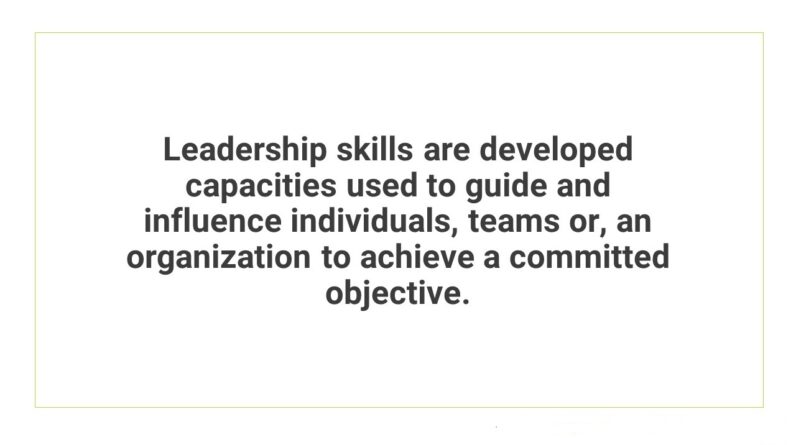 There are a variety of definitions of leadership, from the process of inspiring people to human achievements. As a leader, you influence others and encourage them to do the same. In other words, you act as a catalyst, inspiring growth. But what exactly is leadership? In short, it is the process of influencing others to do something that is in the best interests of the group. Here are a few examples of good leaders and their leadership style.
There are a variety of definitions of leadership, from the process of inspiring people to human achievements. As a leader, you influence others and encourage them to do the same. In other words, you act as a catalyst, inspiring growth. But what exactly is leadership? In short, it is the process of influencing others to do something that is in the best interests of the group. Here are a few examples of good leaders and their leadership style.
Leadership is influence
The ability to influence others is a fundamental element of leadership. Effective leaders use a variety of strategies to influence others, using different approaches to achieve different objectives. Influence is not to be confused with control; it is the ability to know and understand what motivates people and use that knowledge to improve their performance. Here are some examples of ways to influence others. Follow these tips to influence others. Then, read on to learn more about the benefits of leading by influence.
Leadership is influence can work both ways, either positively or negatively. The key to influencing others is to project a positive attitude. A positive attitude will shift the energy of an organization. It is hard to have a positive attitude if you’re constantly surrounded by negative people. If you can’t control your own attitude, people will pick up on this and react negatively. Leadership is not cold or condescending. But when you can influence others, it will work wonders for your career.
When it comes to influence, the first step in leadership is to develop a positive and productive relationship with others. This should be an ongoing process that involves a continuous effort to build trust, respect, and mutual respect. In addition, it is critical to establish the right foundation to foster success. If you want to succeed, you must make the most of every opportunity you have to influence others. In addition to leading others, you must be the best leader for the organization. This is because it will make you more successful. So, start developing your leadership skills by reading a leadership book.
When it comes to influencing people, it is essential to be an example. As leaders, we can use examples of others who have demonstrated their success. Those who do this will be influenced to do the same. It is important to remember that leaders can’t operate on an island; leaders have to be able to influence others. For example, Van Gogh and Schubert operated on an artistic island and influenced others to work together to save the Union. This is not leadership, however, it can be a way to sweat equity for those who have followed their lead.
Leadership is a human achievement
According to the Oxford Strategic Leadership Program, “Leadership is an impression created by communication between the leader and the rest of the stakeholder community”. The impression formed is the outcome of reproduction of information by the majority. This is the traditional view of leadership development. Though this may satisfy those who desire to be told what to do, the concept may not work for everyone. Nevertheless, effective leadership requires a balance of nature and nurture.
A great leader’s success depends on his or her ability to recognize the function of his or her workers and ensure adequate recognition of that function. This in turn allows workers to anticipate satisfaction of their main interests in the group enterprise. In contrast, the crude forms of leadership depend on a single source of satisfaction. It relieves workers’ fears of insecurity by requiring complete compliance with a task. Departures from the task may result in unemployment.
Leadership is a catalyst
To become a catalyst, you must have the courage to think outside the box. Leaders who think outside the box are not the ones who manage people and their emotions; they are catalysts. Catalysts reach out and engage those around them to help them develop and expand. They are the first to ask questions and seek to understand what makes others tick. A catalyst’s actions are as varied as the people they inspire. It could be a drum player who plays a riff for the band leader during the band’s introductions, a single mom who sends her son to his father, or a business owner who gives quarterly awards to improve morale.
A catalyst can inspire others to achieve greatness and help a team achieve its goals. These leaders have the ability to inspire a team to higher heights, and they don’t fear speaking their mind. They have the instinctive ability to motivate others, and they know what they need from their teammates. This trait is crucial to the overall performance of a team. In a leadership context, this means creating the right environment and supporting people.
A catalytic leader knows that change is difficult. People naturally adapt to outdated ways of doing things. When change comes, employees often adopt an “it is what it is” mentality. However, catalytic leaders understand that it is critical to stay ahead of the game. They know that new ideas and concepts need repetition. Therefore, they are willing to repeat their vision over again. This is a very effective way to stay ahead of the curve.
As an organization moves toward more agile processes, they must invest in training and development to develop the right kind of catalyst leaders. Developing these people and promoting catalysts is crucial. While some leaders are born with the natural skills and aptitudes to be catalysts, others must learn how to attract these individuals. Catalysts have an infectious passion and a positive attitude. They inspire others to give and serve. They must also communicate with passion and energy.
Leadership inspires growth
Great leadership inspires growth and innovation. In Leadership inspires growth by Sue Dyer, she outlines the different types of leadership and how they influence the people they lead. Although leaders may be based on fear, punishment, or other motivational factors, they can actually hinder growth and innovation. Rather, leadership that inspires trust can help a team become more effective and engaged. The best leaders understand their teams’ strengths and values, and they know how to cultivate these strengths in their employees.
Inspiring leaders can serve as models of creativity, coping with stress, and tapping into their strengths. Companies are experiencing a period of COVID-19, a time of increased stress and workload, increasing the risk of employee burnout. In order to avoid this, leaders must inspire their teams to overcome these challenges, uplift morale, and create stimulus. By demonstrating their commitment to their team, leaders can foster growth and innovation.
Leadership requires a high level of risk-taking. Leaders like Rosa Parks, Elon Musk, and Henry Ford took risks and made a difference. As Thomas Jefferson said, “With great risk, great reward”. Inspiring leaders use rejection as a learning experience and teach their followers to embrace risk. They don’t apologize for making mistakes and embrace failure as an opportunity for improvement. They inspire others through their positivity and drive to achieve their vision.
Effective leaders demonstrate empathy and value the opinions of others. They give team members adequate time to express their views, and show an interest in their welfare. The best leaders value their team members and prioritize showing them how much they value them. This way, they build trust and increase the likelihood that they will follow them. Communication can inspire growth and improve productivity and efficiency. However, a great leader takes the time to convey their vision and goals to his or her employees. Read more on Essential Leadership Skills






